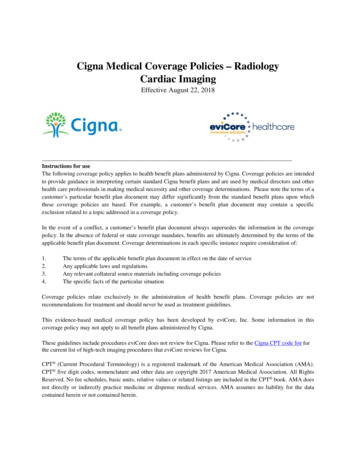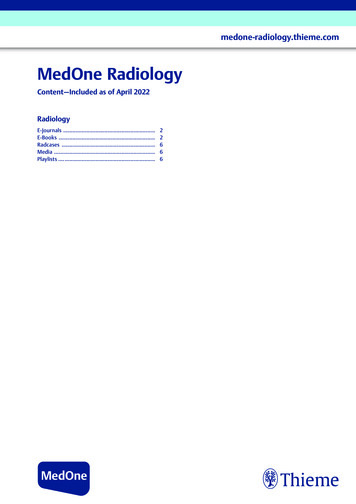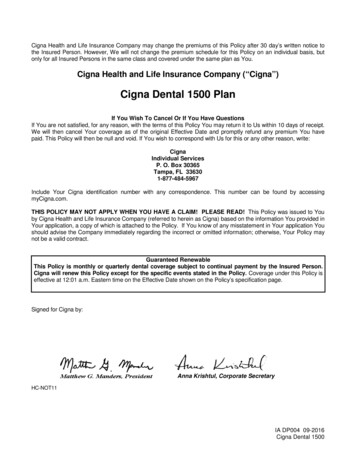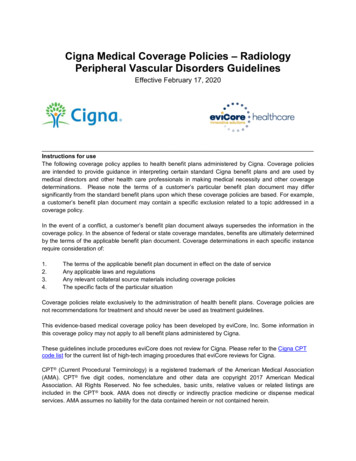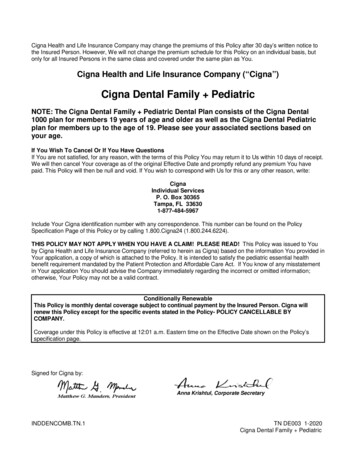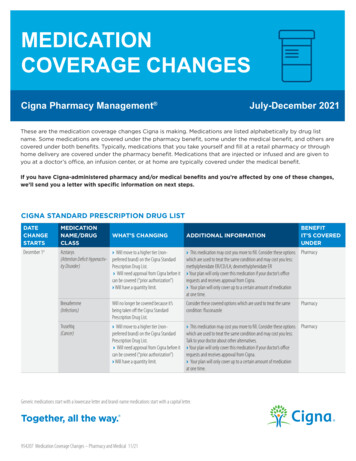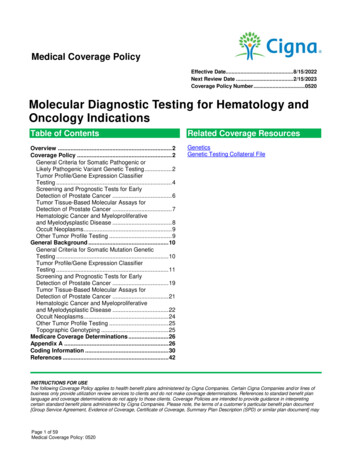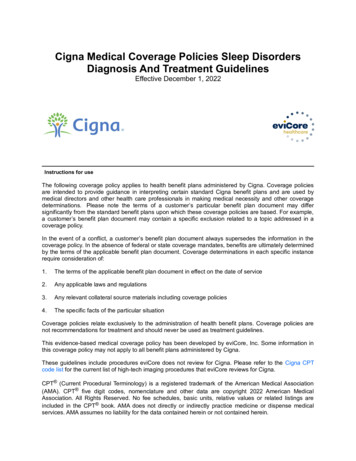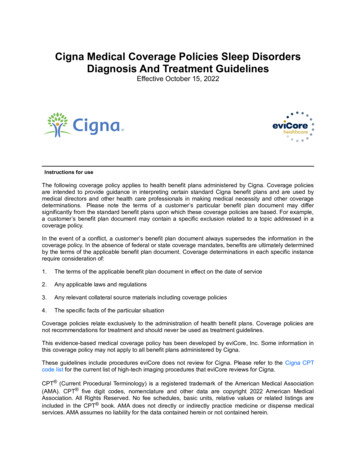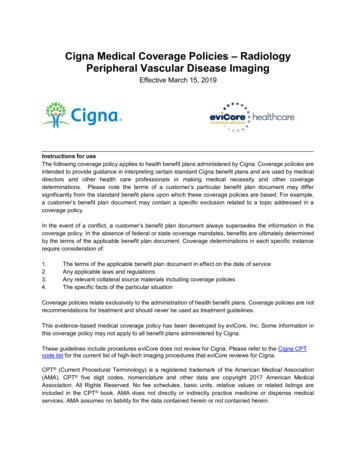
Transcription
Cigna Medical Coverage Policies – RadiologyPeripheral Vascular Disease ImagingEffective March 15, 2019Instructions for useThe following coverage policy applies to health benefit plans administered by Cigna. Coverage policies areintended to provide guidance in interpreting certain standard Cigna benefit plans and are used by medicaldirectors and other health care professionals in making medical necessity and other coveragedeterminations. Please note the terms of a customer’s particular benefit plan document may differsignificantly from the standard benefit plans upon which these coverage policies are based. For example,a customer’s benefit plan document may contain a specific exclusion related to a topic addressed in acoverage policy.In the event of a conflict, a customer’s benefit plan document always supersedes the information in thecoverage policy. In the absence of federal or state coverage mandates, benefits are ultimately determinedby the terms of the applicable benefit plan document. Coverage determinations in each specific instancerequire consideration of:1.2.3.4.The terms of the applicable benefit plan document in effect on the date of serviceAny applicable laws and regulationsAny relevant collateral source materials including coverage policiesThe specific facts of the particular situationCoverage policies relate exclusively to the administration of health benefit plans. Coverage policies are notrecommendations for treatment and should never be used as treatment guidelines.This evidence-based medical coverage policy has been developed by eviCore, Inc. Some information inthis coverage policy may not apply to all benefit plans administered by Cigna.These guidelines include procedures eviCore does not review for Cigna. Please refer to the Cigna CPTcode list for the current list of high-tech imaging procedures that eviCore reviews for Cigna.CPT (Current Procedural Terminology) is a registered trademark of the American Medical Association(AMA). CPT five digit codes, nomenclature and other data are copyright 2017 American MedicalAssociation. All Rights Reserved. No fee schedules, basic units, relative values or related listings areincluded in the CPT book. AMA does not directly or indirectly practice medicine or dispense medicalservices. AMA assumes no liability for the data contained herein or not contained herein.
Imaging GuidelinesV1.0.2019Peripheral Vascular Disease (PVD) ImagingGuidelinesAbbreviations and Glossary for the PVD Imaging Guidelines3PVD-1: General Guidelines4PVD-2: Screening for Suspected Peripheral Artery Disease9PVD-3: Cerebrovascular and Carotid Disease11PVD-4: Upper Extremity Peripheral Vascular Disease16PVD-5: Pulmonary Artery Hypertension18PVD-6: Aortic Disorders and Renal Vascular Disorders and VisceralArtery Aneurysms20PVD-7: Lower Extremity Peripheral Vascular Disease27PVD-8: Imaging for Hemodialysis Access34PVD-9: Arteriovenous Malformations (AVMs)36PVD-10: This section intentionally left blank37 2019 eviCore healthcare. All Rights Reserved.Page 2 of 37400 Buckwalter Place Boulevard, Bluffton, SC 29910 (800) 918-8924www.eviCore.com
Imaging GuidelinesV1.0.2019Abbreviations and Glossary for the PVDImaging Guidelines(See also: Cardiac Imaging Guidelines Glossary)AAAABIabdominal aortic aneurysmankle brachial index: a noninvasive, non-imaging test for arterialinsufficiency – (see toe-brachial index below). This testing can also bedone after exercise if resting results are normal.Claudication or Intermittent claudication: usually a painful cramping sensation ofthe legs with walking or severe leg fatigueCTAcomputed tomography angiographyCTVcomputed tomography venographyDLCOdiffusion capacity: defined as the volume of carbon monoxidetransferred into the blood per minute per mmHg of carbon monoxidepartial pressureDVTdeep venous thrombosisECGelectrocardiogramENTEars, Nose, ThroatHbA1Chemoglobin A1C: test used to determine blood sugar control forindividuals with diabetesMRAmagnetic resonance angiographyMRVmagnetic resonance venographyPADperipheral artery diseasePAHpulmonary artery hypertensionPFTpulmonary function testsPVDperipheral vascular diseaseSVCsuperior vena cavaTIAtransient ischemic attackTTEtransthoracic echocardiogramToeuseful in individuals with ABI above the normal range due to nonBrachialcompressible posterior tibial or dorsalis pedis arteriesIndexV/Q Scanventilation and perfusion scan 2019 eviCore healthcare. All Rights Reserved.Page 3 of 37400 Buckwalter Place Boulevard, Bluffton, SC 29910 (800) 918-8924www.eviCore.com
Imaging GuidelinesV1.0.2019PVD-1: General GuidelinesPVD-1.1: General InformationPVD-1.2: Procedure CodingPVD-1.3: General Guidelines – Imaging557 2019 eviCore healthcare. All Rights Reserved.Page 4 of 37400 Buckwalter Place Boulevard, Bluffton, SC 29910 (800) 918-8924www.eviCore.com
Imaging GuidelinesV1.0.2019PVD-1.1: General Information A current clinical evaluation (within 60 days), including medical treatments, arerequired prior to considering advanced imaging, which includes: Relevant history and physical examination including: The palpation of pulses Evaluation for the presence of arterial bruits Appropriate laboratory studies Non-advanced imaging modalities, such as recent ABIs (within 60 days) aftersymptoms started or worsened Unless there is documented need for routine imaging that is supported by theguidelines. Other meaningful contact (telephone call, electronic mail or messaging) by anestablished individual can substitute for a face-to-face clinical evaluation. The same general risk factors for coronary disease also apply to vascular disease Diabetes is a particularly high risk factor. Age 50, with at least one risk factor, are considered “at risk” for vasculardisease. Erectile dysfunction can be associated with vascular disease. See PV-17: Impotence/Erectile Dysfunction in the Pelvis Imaging Guidelines. Post angioplasty/reconstruction: follow-up imaging is principally guided bysymptoms. See PVD-6: Aortic Disorders, Renal Vascular Disorders, and Visceral ArteryAneurysms CH-29: Thoracic Aorta in the Chest Imaging Guidelines. PVD-7.3: Post-Procedure Surveillance StudiesPVD-1.2: Procedure CodingNon-Invasive Physiologic Studies of Extremity Arteries Limited bilateral noninvasive physiologic studies of upper or lower extremityarteries. Non-invasive physiologic studies of upper or lower extremity arteries, single level,bilateral (e.g., ankle/brachial indices, Doppler waveform analysis, volumeplethysmography, transcutaneous oxygen tension measurement). Complete bilateral noninvasive physiologic studies of upper or lower extremityarteries, 3 or more levels. Non-invasive physiologic studies of upper or lower extremity arteries, multiplelevels or with provocative functional maneuvers, complete bilateral study (e.g.,segmental blood pressure measurements, segmental Doppler waveformanalysis, segmental volume plethysmography, segmental transcutaneous oxygentension measurements, measurements with postural provocative tests,measurements with reactive hyperemia).CPT 9392293923 2019 eviCore healthcare. All Rights Reserved.Page 5 of 37400 Buckwalter Place Boulevard, Bluffton, SC 29910 (800) 918-8924www.eviCore.comPeripheral Vascular Disease (PVD) Imaging Simultaneous venous and arterial systems evaluation are unusual but areoccasionally needed.
Imaging GuidelinesV1.0.2019 CPT 93922 and CPT 93923 can be requested and reported only once for theupper extremities and once for the lower extremities. CPT 93922 and CPT 93923 should not be ordered on the same request nor billedtogether for the same date of service. CPT 93924 and CPT 93922 and/or CPT 93923 should not be ordered on thesame request and should not be billed together for the same date of service. ABI studies performed with handheld dopplers, where there is no hard copy outputfor evaluation of bidirectional blood flow, are not reportable by these codes.Non-Invasive Physiologic Studies of Extremity ArteriesCPT 93924Arterial Duplex – Upper and Lower ExtremitiesCPT Cerebrovascular Artery StudiesCPT Duplex scan of lower extremity arteries or arterial bypass grafts; complete bilateral.93925 A complete duplex scan of the lower extremity arteries includes examination of the fulllength of the common femoral, superficial femoral and popliteal arteries. The iliac, deep femoral, and tibioperoneal arteries may also be examined.Duplex scan of lower extremity arteries or arterial bypass grafts; unilateral or limited93926study. The limited study is reported when only one extremity is examined or when less than a fullexamination is performed (e.g. only one or two vessels or follow-up).Duplex scan of upper extremity arteries or arterial bypass grafts; complete bilateral.93930 A complete duplex of the upper extremity arteries includes examination of the subclavian,axillary, and brachial arteries. The radial and ulnar arteries may also be included.Duplex scan of upper extremity arteries or arterial bypass grafts; unilateral or limited93931study. The limited study is reported when only one extremity is examined or when less than a fullexamination is performed (e.g. only one or two vessels or follow-up).93880Duplex scan of extracranial arteries; complete bilateral study.93882Duplex scan of extracranial arteries; unilateral or limited study. This study is often referred to as a “carotid ultrasound” or “carotid duplex”. Typically, it includes evaluation of the common, internal, and external carotid arteries.Transcranial Doppler StudiesTranscranial Doppler study of the intracranial arteries; complete studyTranscranial Doppler study of the intracranial arteries; limited studyTranscranial Doppler vasoreactivity studyCPT Transcranial Doppler study of the intracranial arteries; emboli detectionwithout intravenous microbubble injectionTranscranial Doppler study of the intracranial arteries; emboli detection withintravenous microbubble injection9389293886938889389093893 2019 eviCore healthcare. All Rights Reserved.Page 6 of 37400 Buckwalter Place Boulevard, Bluffton, SC 29910 (800) 918-8924www.eviCore.comPeripheral Vascular Disease (PVD) ImagingNon-invasive physiologic studies of lower extremity arteries, at rest and followingtreadmill stress testing, complete bilateral study.
Imaging GuidelinesV1.0.2019Venous Studies - ExtremitiesCPT Visceral Vascular StudiesCPT Non-invasive physiologic studies of extremity veins, complete bilateral study (e.g.93965Doppler waveform analysis with responses to compression and other maneuvers,phleborheography, impedance plethysmography). This study is rarely performed.Duplex scan of extremity veins, including responses to compression and other93970maneuvers; complete bilateral study.Duplex scan of extremity veins, including responses to compression and other93971maneuvers; unilateral or limited study. These codes are used to report studies of lower or upper extremity veins. A complete bilateral study of the lower extremity veins includes examination of thecommon femoral, proximal deep femoral, great saphenous and popliteal veins. Calf veinsmay also be included. A complete bilateral study of upper extremity veins includes examination of thesubclavian, jugular, axillary, brachial, basilica, and cephalic veins. Forearm veins mayalso be included.Duplex for Hemodialysis AccessDuplex scan of hemodialysis access (including arterial inflow, body of access andvenous outflow).93975939769397893979CPT 93990PVD-1.3: General Guidelines – Imaging The Ankle Brachial Index (ABI) is a measurement that is calculated by dividing thesystolic pressure at the ankle by the systolic pressure at the arm. This can be doneat the bedside as part of the physical examination and if so does not need preauthorization. When the measurement includes printed Doppler waveforms and areport pre-authorization may be needed (CPT 93922 or CPT 93923). ABI should be measured first: If normal, then further vascular studies are generally not indicated. Imaging Studies: Carotid studies (MRA Neck or CTA Neck) capture the area from the top of theaortic arch (includes the origin of the innominate artery, common carotid artery,and subclavian artery, which gives off the vertebral artery) to the base of theskull. CTA/MRA Abdomen (CPT 74175/CPT 74185) images from the diaphragm tothe umbilicus or iliac crest. 2019 eviCore healthcare. All Rights Reserved.Page 7 of 37400 Buckwalter Place Boulevard, Bluffton, SC 29910 (800) 918-8924www.eviCore.comPeripheral Vascular Disease (PVD) ImagingDuplex scan of arterial inflow and venous outflow of abdominal, pelvic, scrotalcontents and/or retroperitoneal organs; complete studyDuplex scan of arterial inflow and venous outflow of abdominal, pelvic, scrotalcontents and/or retroperitoneal organs; limited studyDuplex scan of aorta, inferior vena cava, iliac vasculature, or bypass grafts;complete studyDuplex scan of aorta, inferior vena cava, iliac vasculature, or bypass grafts;unilateral or limited study
Imaging GuidelinesV1.0.2019 CTA/MRA Chest (CPT 71275/CPT 71555) images from the base of the neck tothe dome of the liver. Runoff studies (CPT 75635 for CTA or CPT 74185, CPT 73725, and CPT 73725 for MRA) image from the umbilicus to the feet. CTA Abdomen and lower extremities should be reported as CPT 75635,rather than using the individual CPT codes for the abdomen, pelvis, and legs MRA Abdomen, MRA Pelvis and MRA Lower extremities should be reportedas CPT 74185, CPT 73725, and CPT 73725. The CPT code for MRAPelvis (CPT 72198) should not be included in this circumstance. If a prior imaging study (Ultrasound, MRA, CTA, Catheter angiogram, etc.) hasbeen completed for a condition, a follow-up, additional, or repeat study for thesame condition is generally not indicated unless there has been a change in theindividual’s condition, previous imaging showed an indeterminate finding, oreviCore healthcare guidelines support routine follow-up imaging.ReferencesPeripheral Vascular Disease (PVD) ImagingGerhard-Herman MD, Gornik HL, Barrett C, et al. 2016 AHA/ACC Guideline on the management ofpatients with lower extremity peripheral artery disease. J Am Coll Cardiol. 2017 Mar 69;(11):14671508. Accessed on November 19, 2017.http://www.onlinejacc.org/content/69/11/1465? ga n TS and Creager MA. The ankle-brachial index as a biomarker of cardiovascular risk: it’s notjust about the legs. Circulation. 2009 Nov 29;120(21):2033-2035. Accessed on November 19, 33. 2019 eviCore healthcare. All Rights Reserved.Page 8 of 37400 Buckwalter Place Boulevard, Bluffton, SC 29910 (800) 918-8924www.eviCore.com
Imaging GuidelinesV1.0.2019PVD-2: Screening for Suspected PeripheralArtery DiseasePVD-2.1: Asymptomatic Screening10 2019 eviCore healthcare. All Rights Reserved.Page 9 of 37400 Buckwalter Place Boulevard, Bluffton, SC 29910 (800) 918-8924www.eviCore.com
Imaging GuidelinesV1.0.2019PVD-2.1: Asymptomatic Screening Resting ABI (CPT 93922) may be appropriate in an asymptomatic individual if thephysical exam is consistent with significant PAD.Background and Supporting InformationThe incidence of PAD increases with age. Screening for PAD is important especially forindividuals with diabetes and smokers, and is generally done as part of a good historyand physical examination. Asymptomatic individuals with normal pulses generally do notneed further testing to assess for PAD.Gerhard-Herman MD, Gornik HL, Barrett C, et al. 2016 AHA/ACC Guideline on the management ofpatients with lower extremity peripheral artery disease. J Am Coll Cardiol. 2017 Mar;69(11):14671508. Accessed on November 19, 2017.http://www.onlinejacc.org/content/69/11/1465? ga in TS and Creager MA. The ankle-brachial index as a biomarker of cardiovascular risk: it’s notjust about the legs. Circulation. 2009 Nov 29;120(21):2033-2035. Accessed on January 25, 33.Saydah SH, Fradkin J, and Cowie C. Poor control of risk factors for vascular disease among adultswith previously diagnosed diabetes. JAMA. 2004 Jan 21;291(3):335-342. Accessed on January article/198035.Hennion DR and Siano KA. Diagnosis and treatment of peripheral arterial disease. Am FamPhysician. 2013 Sep 1;88(5):306-310. Accessed on November 19, Hirsh AT, Criqui MH, Treat-Jacobson D, et al. Peripheral arterial disease detection, awareness, andtreatment in primary care. JAMA. 2001 Sep 19;286(11):1317-1324. Accessed on November 19, icle/194205.Mohler III ER, Gornik HL, Gerhard-Herman M, et VS 2012 appropriate use criteria forperipheral vascular ultrasound and physiological testing part I: arterial ultrasound and physiologicaltesting. J Am Coll Cardiol 2012;60:242–76. Accessed on July 18, 2018.US Preventive Services Task Force, Curry SJ, Krist AH, et al. Screening for Peripheral ArteryDisease and Cardiovascular Disease Risk Assessment With the Ankle-Brachial Index:US PreventiveServices Task Force Recommendation Statement. Jama. 2018;320(2):177.doi:10.1001/jama.2018.8357. 2019 eviCore healthcare. All Rights Reserved.Page 10 of 37400 Buckwalter Place Boulevard, Bluffton, SC 29910 (800) 918-8924www.eviCore.comPeripheral Vascular Disease (PVD) ImagingReferences
Imaging GuidelinesV1.0.2019PVD-3: Cerebrovascular and Carotid DiseasePVD-3.1: Initial Imaging12PVD-3.2: Surveillance Imaging with NO History of Carotid Surgery orIntervention13PVD-3.3: Surveillance Imaging WITH History of Carotid Surgery orIntervention13 2019 eviCore healthcare. All Rights Reserved.Page 11 of 37400 Buckwalter Place Boulevard, Bluffton, SC 29910 (800) 918-8924www.eviCore.com
Imaging GuidelinesV1.0.2019PVD-3.1: Initial Imaging Carotid ultrasound screening in asymptomatic individuals due only to risk factors isnot indicated New signs and symptoms consistent with carotid artery disease (e.g. TIA, amaurosisfugax, change in nature of a carotid bruit) are an indication to re-image the cervicalvessels (regardless of when the previous carotid imaging was performed) using ANYof the following: Duplex ultrasound (CPT 93880 bilateral study or CPT 93882 unilateral study), MRA Neck with contrast (CPT 70548), CTA Neck (CPT 70498). MRA Neck with contrast (CPT 70548) or CTA Neck (CPT 70498) can beperformed if duplex Ultrasound shows / 70% occlusion/stenosis of the internalcarotid artery. MRA Head (CPT 70544) or CTA Head (CPT 70496) can be added if carotidintervention is planned. MRA Neck (CPT 70548) or CTA Neck (CPT 70498) can be performed if ultrasoundfindings suggest ulcerated plaque. Surveillance imaging once a year for individuals with fibromuscular dysplasia of theextracranial carotid arteries. For follow-up imaging of known carotid disease See PVD-3.2: Surveillance Imagingwith NO History of Carotid Surgery or Intervention. 2019 eviCore healthcare. All Rights Reserved.Page 12 of 37400 Buckwalter Place Boulevard, Bluffton, SC 29910 (800) 918-8924www.eviCore.comPeripheral Vascular Disease (PVD) Imaging Duplex ultrasound (CPT 93880 bilateral or CPT 93882 unilateral), prior toconsidering advanced imaging, can be used to evaluate possible carotid arterydisease when ANY of the following apply: Hemispheric neurologic symptoms including stroke, TIA, or amaurosis fugax Non-hemispheric or unexplained neurologic symptoms Known or suspected retinal arterial emboli or Hollenhorst plaque Suspected carotid dissection Pulsatile neck masses Carotid or cervical bruit Abnormal findings on physical exam of the carotid arteries (e.g. aneurysm orabsent carotid pulses) Preoperative evaluation of individuals with evidence of severe diffuseatherosclerosis, scheduled for major cardiovascular surgical procedures Preoperative evaluation of individuals prior to elective coronary artery bypassgraft (CABG) surgery in individuals older than 65 years of age and in those withperipheral artery disease, history of cigarette smoking, history of stroke or TIA, orcarotid bruit Suspected Subclavian Steal Syndrome See CH-27: Subclavian Steal Syndrome in the Chest Imaging Guidelines Blunt neck trauma Vasculitis potentially involving carotid arteries
Imaging GuidelinesV1.0.2019PVD-3.2: Surveillance Imaging with NO History of Carotid Surgery orIntervention For Typical Symptoms of TIA/Stroke or Carotid Dissection: See HD-21: Stroke/TIA. For Suspected Vertebrobasilar Pathology: Initial Imaging See HD-21: Stroke/TIA. Surveillance Imaging Asymptomatic or unchanged symptoms and known vertebrobasilar disease orpost-stenting interval determined by Vascular Specialist. For Suspected Subclavian Steal Syndrome: Initial Imaging See CH-27: Subclavian Steal Syndrome. Surveillance of Asymptomatic Individuals with Carotid Artery Disease that have NOThad Carotid Surgery or Intervention 70% Carotid Stenosis Duplex ultrasound (CPT 93880 bilateral or CPT 93882 unilateral) can beperformed at the following intervals: Annually for the first 3 years Every 2 years thereafter if stable. If increased stenosis is seen on imaging, may image annually until stablefor 3 years. 70% Carotid Stenosis Duplex ultrasound (CPT 93880 bilateral or CPT 93882 unilateral) or MRANeck with contrast (CPT 70548) or CTA Neck (CPT 70498) can beperformed at the following intervals: Every 6 months until intervention is performed or a decision is made to notintervene.PVD-3.3: Surveillance Imaging WITH History of Carotid Surgery orIntervention 70% residual carotid stenosis after intervention Duplex ultrasound (CPT 93880 bilateral or CPT 93882 unilateral) can beperformed at the following intervals: At 1 month after procedure Every 6 months for 2 years after procedure Then annually until stability has been established 70% residual carotid stenosis or aggressive restenosis pattern Duplex ultrasound (CPT 93880 bilateral or CPT 93882 unilateral) can beperformed at the following intervals: At 1 month after procedure Every 6 months after procedure until stable Annually after stability has been established 2019 eviCore healthcare. All Rights Reserved.Page 13 of 37400 Buckwalter Place Boulevard, Bluffton, SC 29910 (800) 918-8924www.eviCore.comPeripheral Vascular Disease (PVD) Imaging After Intracranial Hemorrhage: Initial Imaging See HD-13.1: Head Trauma. Surveillance Imaging Interval determined by neurosurgeon or neurologist.
Imaging GuidelinesV1.0.2019Background and Supporting Information Carotid intima-media thickness using duplex ultrasound imaging (Category III code0126T) is not recommended in clinical practice for risk assessment for a first ASCVDevent. Although outcomes data are lacking, Texas has adopted this method in TexasHeart Attack Preventive Screening Bill (HR 1290). Texas Heart Attack Preventive Screening Law (HR 1290) mandates that insurers inTexas cover either a calcium scoring study (CPT 75571 or HCPCS S8092) or acarotid intima-media thickness study (ultrasound—Category III code 0126T) everyfive years for certain populations. To qualify, the following must apply: Must be a Texas resident Must be a member of a fully-insured Texas health plan Must be a man age 45 to 75 or a woman age 55 to 75 Must have either diabetes or a Framingham cardiac risk score of intermediate orhigher Must not have had a calcium scoring study or a carotid intima-media thicknessstudy within the past 5 yearsReferencesBrott TG, Halperin JL, Abbara S, et al. SNIS/SVM/SVSGuideline on themanagement of patients with extracranial carotid and vertebral artery disease. Circulation. 2011 Jul25;124:489-532. Accessed on November 19, 2017. .Gerhard-Herman M, Gardin JM, Jaff M, et al. Guidelines for noninvasive laboratory testing: a reportfrom the American Society of Echocardiography and the Society of Vascular Medicine and Biology. JAm Soc Echocardiogr. 2006 Aug;19(8):955-972. Accessed on January 25, 06)00406-8/fulltext.vonReutern GM, Goertler M-W, Bornstein NM, et al. Grading carotid stenosis using ultrasonicmethods. Stroke. 2012 Mar;43(3):916-921. http://stroke.ahajournals.org/content/43/3/916. Accessedon November 19, 2017.Needleman L, Paushter DM, Cohen HL, et al. ACR-AIUM-SPR SRU Practice parameter for theperformance of an ultrasound examination of the extracranial cerebrovascular system. Revised 2016(Resolution 28). ameters/usextracranialcerebro.pdf?la en. Accessed January 25, 2018.Brott TG, Halperin JL, Abbara S, et al. SIR/SNIS/SVM/SVS Guideline on themanagement of patients with extracranial carotid and vertebral artery disease. J Am Coll Cardiol.2011 Feb;57(8):1002-1044. ull.pdf. Accessed onJanuary 25, 2017.Post PN, Kievit J, van Baalen JM, et al. Routine duplex surveillance does not improve the outcomeafter carotid endarterectomy: a decision and cost utility analysis. Stroke. e37/c0f8a68bd4b2b170b5b00ee51a2f547c080c.pdf. Accessed onJanuary 25, 2018.Moresoli P, Habib B, Reynier P, et al. Carotid stenting versus endarterectomy for asymptomaticcarotid artery stenosis. Stroke. 2017 Aug;48(8):2150–2157. Accessed November 27, 50. 2019 eviCore healthcare. All Rights Reserved.Page 14 of 37400 Buckwalter Place Boulevard, Bluffton, SC 29910 (800) 918-8924www.eviCore.comPeripheral Vascular Disease (PVD) Imaging MRA Neck (CPT 70548) or CTA Neck (CPT 70498) may be indicated if ultrasoundis technically difficult or confirmation of the degree of stenosis on ultrasound isneeded because an interventional procedure is being considered.
V1.0.2019Rogers RK and Bishu K. Optimal treatment of extracranial carotid artery disease: carotidendarterectomy, carotid stenting, or optimal medical therapy. Current Cardiology Reports. 2015 Oct;17(10):84. Accessed November 27, 2017. -0150636-2.Al Shakarchi J, Lowry D, Nath J, et al. Duplex ultrasound surveillance after carotid arteryendarterectomy. J Vasc Surg. 2016 Jun;63(6):1647-1650. Accessed November 27, /pii/S0741521416002172.AbuRahma AF, Srivastava, M, AbuRahma Z, et al. The value and economic analysis of routinepostoperative carotid duplex ultrasound surveillance after carotid endarterectomy. J Vasc Surg. 2015Aug;62(2):378-384. Accessed November 27, pii/S0741521415003687.Aboyans V, Ricco J-B, Bartelink M-LEL, et al. 2017 ESC Guidelines on the diagnosis and treatmentof peripheral arterial diseases, in collaboration with the European Society for Vascular Surgery(ESVS): document covering atherosclerotic disease of extracranial carotid and vertebral, mesenteric,renal, upper and lower extremity arteries Endorsed by: the European Stroke Organization (ESO) TheTask Force for the Diagnosis and Treatment of Peripheral Arterial Diseases of the European Societyof Cardiology (ESC) and of the European Society for Vascular Surgery (ESVS). Eur Heart J. 2017Aug 26. Accessed November 27, i/10.1093/eurheartj/ehx095/4095038.Naylor AR, Ricco J-B, de Borst GJD, et al. Management of atherosclerotic carotid and vertebral arterydisease: 2017 clinical practice guidelines of the European Society for Vascular Surgery (ESVS). Eur JVasc Endovasc Surg. 2018 Jan;55(1):3-81. Accessed November 27, 395-7/fulltext.Mohler III ER, Gornik HL, Gerhard-Herman M, et VS 2012 Appropriate use criteria forperipheral vascular ultrasound and physiological testing part I: arterial ultrasound and physiologicaltesting. J Am Coll Cardiol 2012;60:242–76. 1743/fulltext. Accessed on July 18, 2018.Goff DC Jr, Lloyd-Jones DM, Bennett G, et al. 2013 ACC/AHA guideline on the assessment ofcardiovascular risk: a report of the American College of Cardiology/American Heart Association TaskForce on Practice Guidelines. J Am Coll Cardiol 10.1161/01.cir.0000437741.48606.98. Accessed August 3, 2018. 2019 eviCore healthcare. All Rights Reserved.Page 15 of 37400 Buckwalter Place Boulevard, Bluffton, SC 29910 (800) 918-8924www.eviCore.comPeripheral Vascular Disease (PVD) ImagingImaging Guidelines
Imaging GuidelinesV1.0.2019PVD-4: Upper Extremity Peripheral VascularDiseasePVD-4.1: Upper Extremity PVD – Imaging17 2019 eviCore healthcare. All Rights Reserved.Page 16 of 37400 Buckwalter Place Boulevard, Bluffton, SC 29910 (800) 918-8924www.eviCore.com
Imaging GuidelinesV1.0.2019PVD-4.1: Upper Extremity PVD – Imaging ONE or MORE of the following imaging studies may be required when clinicalevidence points to arterial insufficiency (arm or hand claudication, discoloration,unilateral cold painful hand) or venous insufficiency (swelling, etc.), which may alsoinclude emboli from aortic arch plaque rupture: Arterial ultrasound of the upper extremities (CPT 93930 or CPT 93931), or CTA/CTV of Upper extremity (CPT 73206) or MRA/MRV of Upper extremity(CPT 73225), and/or CTA/CTV Chest (CPT 71275) or MRA/MRV Chest (CPT 71555). For Superior Vena Cava Syndrome (upper extremity and facial symptoms): CT Chest with contrast (CPT 71260). MRV (CPT 71555) or CTV (CPT 71275) Chest may be considered whenstenting of the SVC is being considered
1. The terms of the applicable benefit plan document in effect on the date of service. 2. Any applicable laws and regulations. 3. Any relevant collateral source materials including coverage policies. 4. The specific facts of the particular situation. Coverage policies relate exclusively to the administration of health benefit plans. Coverage .
